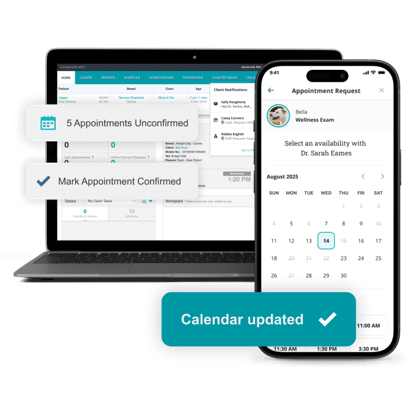What Every Practice Needs to Know About Veterinary Client Retention in 2025

As the veterinary industry moves further into 2025, one thing is clear: Veterinary client retention is imperative. While many in veterinary medicine focus the bulk of their marketing strategy on acquiring new clients, industry data shows that growth depends equally on existing clients returning for routine check-ups, vaccinations, and preventive care.
We explain why veterinary client retention is more urgent now than in years past and what your veterinary practice can do differently in 2025 to maintain client loyalty.
Why veterinary client retention matters
According to the July 2024 KPI Quarterly Commentary, published by the Veterinary Hospital Managers Association (VHMA), patient visit volume is down. This decline is likely attributed to inflation, pet parent price sensitivity, and the rising costs of pet ownership.
With fewer appointments booked, veterinary clinics can no longer afford to let existing clients drift away. Instead, practices should prioritize reengagement and loyalty to build a more substantial client base. VHMA suggests two main goals: bringing back lapsed clients and strengthening existing client relationships.
The digital expectation
Modern pet parents are digital natives or fluent technology adopters. These clients expect businesses, including veterinary practices, to offer convenience and easy access. If appointment scheduling requires a phone call during business hours or involves long wait times, they’re likely to look for another hospital that offers more convenient booking options—even if they already know and love your staff.
Consistent client communication
Poor client communication is one reason people leave service providers. Whether it’s missed follow-ups, unclear post-consultation instructions, or cold interactions at the front desk, these lapses in communication slowly erode client satisfaction. Eventually, clients who feel slighted will decide to take their business elsewhere.
However, the opposite is also true. Consistent, warm, and helpful communication builds client loyalty to keep them coming back. Communication should start with the first interaction and continue across all touchpoints, from scheduling to follow-up.
Client loyalty programs and incentives
In 2025, veterinary client retention involves giving pet owners a compelling reason to stay with your practice. Loyalty programs can be highly effective for this purpose, especially when they are simple and easy for both clients and veterinary professionals to manage.
Many practices find success with loyalty programs that offer the following benefits:
- Discounts on bundled pet care services or wellness plans
- Points that accumulate with purchases and can be redeemed for veterinary services
- Referral bonuses for introducing new clients to the practice
Incentives encourage repeat visits and make pet owners feel recognized and appreciated. They can also help shift the veterinary-client relationship from transactional to relational, converting new clients into long-term, committed pet owners.
Reengaging lapsed veterinary clients
Clients who haven’t visited the clinic in over a year represent a unique opportunity for reengagement. Consider offering discounted wellness exams, check-ups, or other services to bring back your lapsed clients. After running a report in your PIMS to identify lapsed clients, send a targeted email, text message, or app notification offering an exclusive, limited-time deal. When clients bite, use the visit to learn about and address the barriers that kept them from returning before, such as cost, poor communication, or a bad experience.
Measuring client retention
To improve veterinary client retention, you need to understand how it affects your practice. Start by measuring and analyzing metrics that indicate the success or failure of a new endeavor, such as marketing or retention strategies. Use your PIMS to pull reports and look for trends in the following areas:
- Client return rate
- Average client lifespan
- Referral rate
- No-show and cancellation rate
- Loyalty or wellness plan participation
Your practice management software should simplify the process of pulling reports and spotting patterns. If you find the reporting features of your current system clunky, consider switching to a more user-friendly and streamlined cloud-based system.
Leveraging the veterinary team
Technology can automate and support your client retention strategy, but your veterinarians and staff members bring it to life. When team members are overworked or undertrained, even the best efforts will fall flat. Train your team to use empathy and active listening to improve the client experience. From answering billing questions to delivering bad news, your team’s emotional intelligence plays a huge role in whether pet owners return.
Retaining clients doesn’t just happen—it’s the result of strategic decisions, hard work, and consistency in implementing the right strategies. In 2025, veterinary marketing can help teams attract potential clients, focus on keeping existing pet owners happy, and reengage lapsed clients to optimize relationships and maximize clinic success.




